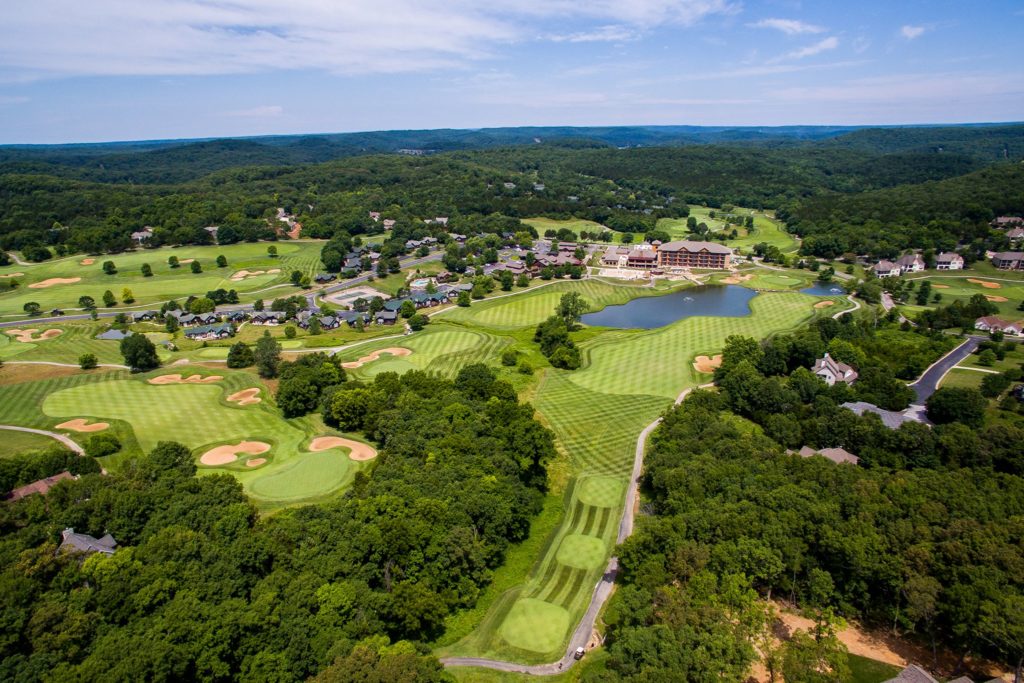
Osage National Golf Club
With some 14 golf courses — no, you’re not dreaming — the Lake of the Ozarks in Missouri provides not only plenty of options to tee it up, but is also super convenient to get to with both St. Louis and Kansas City nearby, not to mention the state capital of Springfield just a 90-mile jaunt away.
The area is popular with boaters and fisherman, but a big part of the allure of the region is the 14 courses, each routed through a combination of forests, water and elevations carved and the rolling hills that will challenge any game, from weekend duffer to low-handicapper.
Lake of the Ozarks vacations are defined by the lake, which is the largest manmade body of water in the midwestern United States, with more than 1,100 miles of shoreline in four different Missouri counties. The area has many waterfront accommodations, restaurants and recreational and entertainment venues as well as a wide variety of lodging, restaurants, state parks and other recreational activities to suit any budget and taste.
The Travel Caddie has teed it up at a handful of the courses, including the 27-hole Osage National, Old Kinderhook, the Cove Course at the Lodge at the Four Seasons and the Oaks Course at the Margaritaville Resort – over a three-day period and interspersed a lovely boat trip on the lake, fine dining throughout and relaxing nights under the clear, star-filled skies.

Old Kinderhook

Cove Course at the Lodge at the Four Seasons
Osage National
One of those days featured a round at the fabulous Osage National Golf Resort, home of Missouri’s only Arnold Palmer Signature course and 27 holes of championship golf set in a beautiful valley surrounded by the imposing bluffs of the Osage River.
Taking the challenge at Osage National brings three distinct nines – the River, the Mountain and the Links – into play. The River and Mountain nine were Palmer’s original layout and opened for play in 1992 and was the site of a course-opening skins game between Palmer, Payne Stewart, Lee Trevino and Tom Watson that seems like the stuff of legend when you are on the course.
The Links nine opened in 1998, and combining all three nines gives the course’s operators the opportunity to fill the day with different rotations for 18, 27 or 36 holes of golf.
The course offers consistently large, well-manicured greens with mild undulation, Zoysia fairways and five sets of tees to provide a true golf test for any skill level.
The River (which plays to 3,543 yards, shortest of the three) brings water into play on every hole. The side begins with the 398-yard first, a par-4 with a pond down the right side from landing area to green, and ends with a 626-yard par-5, which requires a drive over water and a third-shot approach past a large bunker left and a series of mounds right.
Among the other trials on River nine: the grip-it-and-rip-it, 445-yard par-4 second, with a putting surface engirded by sand on three sides; the 216-yard par-3 fourth, where you must carry a water hazard and a foot-shaped bunker to a green that slopes rightwards; the risk-reward, 315-yard par-4 sixth, which is better played as a two-shot hole because of a forced carry over water and several trees on your line to the green; and No. 8, a 442-yard par-4 with a huge bunker on the left the entire length and the tree-lined Osage River right.
The Mountain nine offers its own set of tests. The true strength of this side are its par-4s, including the 420-yard 12th (the course’s signature hole), which drops from an elevated tee to a fairway that slopes severely to the right and an approach that heads back uphill to a putting surface that moves from left to the right and back to front. Then there is the 484-yard, dual-tiered par-4 eighth, which forces a lay-up short of a deep drop midway to the green before descending to a green protected front-right by a huge, deep bunker.
The par-5s on Mountain include the 588-yard fifth, which features another elevated tee shot that must be placed to the right to a blind landing area and a third-shot approach to a green protected by a pond left. The 555-yard ninth, a boomerang-shaped dogleg-left that culminates at a bunker-flanked green higher than the fairway.
Links is relatively flat after the uphill 377-yard first, which ends at a 21-yard-deep, two-tiered green. No. 2 is a 455-yard par-4 with a forced carry over tall, native grasses, and the uphill and tight, 441-yard fifth has a green that is just 17 yards wide but 37 yards deep, so choose the correct club here.
The par-5 seventh is, at 612 yards, a true three-shotter, and not just because of its length. The drive is made difficult by a bunker and water left and the lay-up is over water to a tight landing area with sand and mounds on both sides. Completing the Links nine is a reachable-in-two, 512-yard par-5 with a green pinched on three sides by water.
Additional golf amenities at Osage National Golf Resort include a 20,000-square foot clubhouse, an award-winning pro shop and an expansive practice area with driving range and chipping and putting greens. This place offers a little bit of everything and a whole lot of fun.

Club at Old Kinderhook
For more of the same challenges as Osage National taken to an even higher level of quality golfers can tee it up at the Club at Old Kinderhook, a flawless Tom Weiskopf design. The course meanders through the Ozark Hills, turning rolling topography, rock waterfalls and flowering trees into a challenging and pleasant track from start to finish. Each hole seems to capture a special aspect of the terrain and offers an experience to delight golfers of all skill levels.
Opened for play in 1999, Old Kinderhook has no tricked-up design elements and few forced carries, sporting fairways with reasonable width in a fair, but demanding, routing.
The course is a 6,855-yard par-71 layout featuring Zoysia tees and fairways and large Bentgrass greens. Beginning with the 430-yard first hole and reaching its crescendo with back-to-back two-shotters at the 432-yard fourth and the 446-yard fifth, Old Kinderhook’s front-side is defined by its par-4s.
Water is prevalent on Nos. 4, 5 and 8 (another testing par-4 that asks you to play over a creek and right of the pond that sides the green on the left), but is not a problem for the low-handicap player. The putting surfaces are offset on hole Nos. 4, 6 and 9, the latter of which is the front’s lone par-5 and – at 514-yards – can be reached by two long and accurate shots.
While the par-4 10th is a force to be dealt with, the back-nine at Old Kinderhook switches tack and relies on its two par-3s and pair of par-5s to add spice and challenge. Carded at 202 yards, the 11th plays to a shallow green flanked both left and right by sand. The back’s other one-shotter is the 206-yard 16th, which can be a bear if the hole is placed on the back right of the deep, oval-shaped putting surface and over a bunker.
Golf Digest has lauded Old Kinderhook with a 4½-star rating while Golfweek has ranked the course as one of the top semi-private courses in Missouri. Old Kinderhook will challenge the most serious golfer, but plays on the friendly side.
Along with the two practice greens, an 11-acre practice facility, short game and bunker practice areas, Old Kinderhook also features a golf shop, a member clubhouse with locker rooms, two restaurants and a banquet center with meeting space.

Old Kinderhook
The Lodge at the Four Seasons and the Margaritaville Resort add to the fun
Two other tracks we played on the trip — the Robert Trent Jones-designed Cove Course at The Lodge of the Four Seasons, and The Oaks Course at Tan-Tar-A, fashioned by the renowned architecture duo of Bruce Devlin and Robert Von Hagge — were both fun and challenging in their own right. Both make great companion courses to the ones listed above.
The Cove Course, opened in 1973 as the original track of the three courses offered for play at The Lodge of the Four Seasons, is a challenge for golfers of all skill levels. With 72 bunkers, rolling hills, and water coming into play on nine of the holes, it’s anything but tame. In typical RTJ fashion, The Cove is a target golf course putting an emphasis on getting the ball in play off of the tee.
Every golfer will leave with a memory of The Cove’s fourth hole, the resort’s signature par-3. Playing at 230 yards from the tips, it’s all carry over from The Lake’s famed “Witch’s Cove.”
There are two other golf options at the Lodge of the Four Seasons – The Ridge, a Ken Kavanaugh-designed, resort-style golf course that’s very player-friendly and sports the requisite rolling hills, natural rock outcroppings, native wildflowers and beautiful views of the lake; and the private, and finer-than-fine, Club at Porta Cima, a Jack Nicklaus Signature Design with seven holes along the lake that’s considered one of Missouri’s top courses. Guests at the Lodge of the Four Seasons have limited access to playing this track — if you can get on, it’s a must-play.
The Oaks at the Margaritaville Resort, formerly Tan-Tar-A, places a premium on accurate shots and strategic course management. With playful approaches, challenging Bentgrass putting surfaces, water hazards, and 60 sand bunkers amid lakeside beauty, the par-71 course takes golfers on a journey through the Missouri forests, over rolling hills and up to the banks of the sparkling lake of the Ozarks.
Multiple tee boxes and beautiful Bermuda and zoysia fairways make the Oaks a unique and enjoyable experience.
The Oaks was host to the 1994 PGA Club Pro Championship, the largest professional tournament of its kind and challenged some of the best club professionals in the country.

